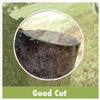Why Prune?
- Dead or Diseased Branches
- Crowded Or Rubbing Limbs
- Storm Damage
- Air & Light Penetration To Crown
- Obstructing Lower Branches
- Shape & Design
- Structure
- House Clearance
- Safety!
Pruning Tips
 Pruning is a very common tree maintenance procedure. A good rule of thumb to remember when pruning is to never take out more than 25% of the crown. You should also make sure that living branches compose at least 2/3 of the height of a tree.
Pruning is a very common tree maintenance procedure. A good rule of thumb to remember when pruning is to never take out more than 25% of the crown. You should also make sure that living branches compose at least 2/3 of the height of a tree.
Pruning more can be harmful to your tree. The main reasons for pruning are health, aesthetics and safety.
Interesting Facts About Trees
- Well-maintained trees and shrubs can increase property value by up to 14%.
- Trees properly placed around buildings can reduce air conditioning needs by 30%
- A healthy tree can have a value of up to $10,000.
- The shade and wind buffering provided by trees reduces annual heating and cooling costs by 2.1 billion dollars.
- A single tree produces approximately 260 pounds of oxygen per year. That means two mature trees can supply enough oxygen annually to support a family of four.
- One tree can absorb as much carbon in a year as a car produces while driving 26,000 miles.
- Over the course its life, a single tree can absorb one ton of carbon dioxide.
- 40 isn't old if your a tree :)







